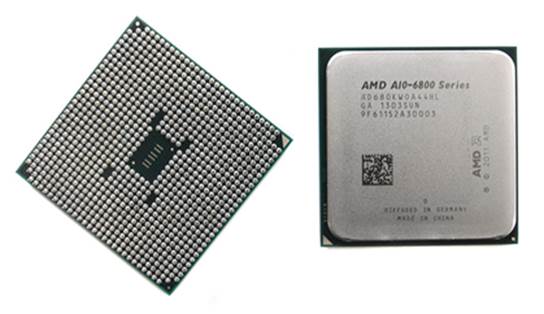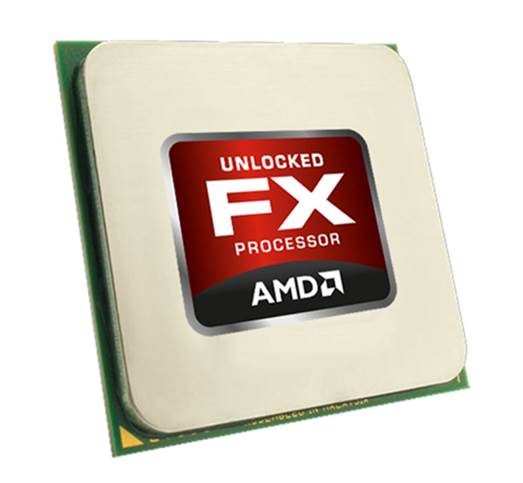It might not be quite as important in this
3D-accelerated age of powerful graphics cards, but your PC’s CPU is still a
crucial component when it comes to game performance. This tiny thumbnail-sized
wonder of silicon magic is responsible for most of the back-end work, feeding
the framework of the world to the GPU, while also giving each of the enemy
characters a brain, calculating the effects of gravity when a building
collapses, and much, much more. Yet with dozens of different CPUS on the
market, all with nonsensical names that don’t illustrate their performance,
choosing the right one is harder than landing a 360 no scope at 500m
range…after drinking a bottle of bourbon. So we’ve looked at four of the most popular
gaming CPUs on the market, to help you determine which one is best for your
needs.
AMD A10-6800K
Not for the hardcore
Price: $169
If AMD hadn’t purchased ATI several years
ago, this CPU would never exist. That’s because it’s part of AMD’s APU (accelerated
Processing Unit) range, which combine a standard CPU with an integrated GPU,
all on the one chip.

AMD
A10-6800K
From a hardcore PC gamer’s perspective,
this is irrelevant, as we use dedicated graphics cards that are several times
faster than an integrated GPU. All we care about is this CPU’s raw computing
performance. Our benchmarks show, the A10-6800K is around 30% slower than
Intel’s i7-4770K In games that rely more on GPU performance that’s not a huge
problem, but many games still require a fast CPU to run well. A few examples
include Planet side 2, Battlefield 3, Far Cry 3, and any flight sim you can
name; these games will all run at around two thirds of the speed of an Intel
CPU, sometimes even worse. This fast is counterweighed by the fact that the
A10-6800K is less than half the price of the Intel i7-4770K, so it’s quite a
potent performer for the price.
We still wouldn’t recommend this for a
gaming PC though; where the A10-6800K would shine is in a mini-PC designed to
handle very basic, casual games.
Verdict: 7/10
·
Harcore PC gamers won’t find what they’re
looking for, but casuals will be happy with integrated graphics performance.
·
Decent price versus performance
·
Best integrated graphics
·
Works in Older Mobos
·
Very average pure CPU performance
·
Uses lots of power
·
Runs rather hot
AMD FX-8350
Out-cooled, outclassed and out-priced
Price: $225
Unlike the A10-6800K, which is designed for
use in All-in-ones and laptops, the FX-8350 has a single goal in mind; pure,
raw, desktop performance. It’s a bloody behemoth of a processor, packing a
crazy eight CPU cores under the heat shield, with no integrated GPU. For those
of you unfamiliar with what a core is, it’s essential a single CPU, with
today’s CPUs actually containing multiple CPUs in one package. While Intel’s
mainstream line maxes out at just four cores, AMD has gone the whole hog with
the FX series and created an octo-core processor.

AMD
FX-8350
Sounds pretty cool, but there’s one slight
problem. Multi-cored CPUs are a relatively recent innovation, and game
developers are still figuring out how to get multiple cores to all work
harmoniously. Most games still only use one or two cores, with a select few
fully utilizing four cores. Therefore, the FX-8350’s eight cores are really
only useful for multi-tasking, as Windows can spread the load of multiple
applications around all eight, but during games half of these cores sit idle,
twiddling their thumbs.
When it comes to the single-cored
performance of the FX-8350 versus the single-cored performance of Intel’s
i7-4770K, AMD’s chip is left wanting. As you can see from our test, which is
very CPU dependent, the FX-8350 is almost 20% slower than the i7. The same
difference exists in our synthetic gaming test, 3DMark’s Fire Strike test.
We’ve seen other tests showing an even greater performance gap of up to 40%, so
it’s definitely not the fastest CPU around. Helping to balance this out though
is the cost difference, with the FX-8350 around half the price of the Intel
chip – not bad considering it’s only 20% slower in most situations.
Unfortunately there are cheaper Intel CPUs such as the Core i5-4670 that are
basically the same price as the FX-8350, but are substantially quicker in most
games.
There’s most good news for AMD though, with
the fact that the FX-8350 is fully multiplier unlocked. This makes it very easy
to overclock, and speeds approaching 5GHz aren’t unheard of. The last benefit
is potentially massive, but is yet to be realized. With both the PlayStation 4
and Xbox One using eight-core AMD CPUs, game developers are going to have to
start writing for eight cores. AMD’s FX-8350 could have a huge performance
increase over Intel’s four cored CPUs in these titles, putting AMD back in the
performance lead for the first time in years. However, it’s likely Intel has an
eight-cored CPU waiting in the wings for just this moment, so AMD might only
have the briefest of windows to capitalize on this benefit.
Until then, sadly the FX-8350 is outclassed
by Intel’s entry level i5 series, so it’s case of wait and see for the FX-8350.
Verdict: 7/10
·
AMD tool a gamble with so many cores, and
unfortunately its time still hasn’t come.
·
Affordable price
·
Fully multiplier unlocked
·
Solid performance
·
Slower than similarly priced Intel CPUs
·
Very hot
·
Most cores unused
AMD’s new FX-9590
Just as we were going to print, AMD demoed
its FX-8350 successor at E3 2013. Known as the FX-9590 it ships with a default
speed of 5GHz, making it the fastest consumer CPU ever made, in terms of
frequency at least. We’ll be getting one in to review in the very near future,
but be warned – this power guzzler sucks down a crazy 220W of power, so you’re
going to need some serious cooling to keep it from melting.

AMD’s
new FX-9590